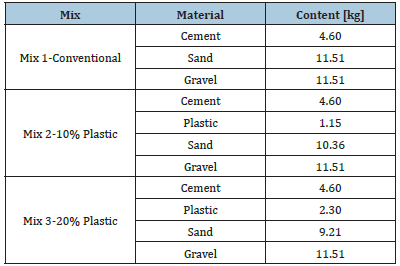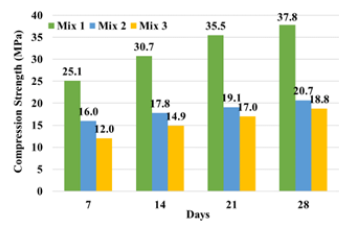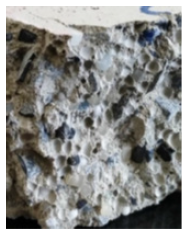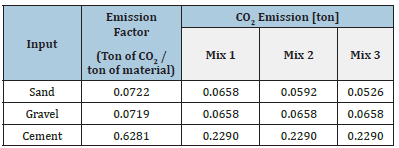- Submissions

Full Text
Advancements in Civil Engineering & Technology
Valuation of Plastic Waste as Fine Aggregate in Concrete Pavers
Stéphanie Rocha1,2,3, Jesse Lima2, Pedro Quintino2, Luana Vasconcelos3 and Lino Maia1,4*
1Construct-Labest, Faculty of Engineering (FEUP), University of Porto, Portugal
2FASA, Santo Agostinho Faculty, Av. Osmane Barbosa, Brazil
3Center of Exact and Technological Sciences, State University of Montes Claros (UNIMONTES), Campus Prof. Darcy Ribeiro, Brazil
4Faculty of Exact Sciences and Engineering, University of Madeira, Campus da Penteada, Portugal
*Corresponding author:Lino Maia, Construct-Labest, Faculty of Engineering (FEUP), University of Porto and Faculty of Exact Sciences and Engineering, University of Madeira, Campus da Penteada, 9020-105 Funchal, Portugal
Submission: November 21, 2022;Published: December 01, 2022

ISSN: 2639-0574 Volume5 Issue3
Abstract
Polymers are manufactured in large scale; however, their recycling does not reach large proportions in countries like Brazil. This material can be incorporated into products used in civil construction, as this sector has been standing out in the use of waste, reducing the consumption of natural resources. The purpose of this study was to evaluate substitution of natural aggregate by plastic waste in pavers to decrease the amount of waste in landfills. Dimensional evaluation, water absorption tests, compressive strength and abrasion strength were carried out. According to analyses carried out, the pavers with plastic did not reach values for the compression required in Brazilian norms, however, it is suggested that the strength found is suitable for walkways. In addition, the environmental advantages of using plastic as a fine aggregate in the pavers was evaluated.
Keywords:Construction Materials; Plastic Waste; Pavers; Recycling; Sustainability
Introduction
One of the biggest problems arising from urbanization is the increase of solid waste generation. The population increase and the search to improve the quality of life, caused by purchasing power, makes the industries have a vast production of materials, which after consumption they are soon discarded. The increase in solid waste, through the consumption of disposable products such as paper, plastic and glass, causes decrease in the useful life of landfills, with high environmental impact [1]. In 2012, Brazil produced around 200000 tons per day of solid waste, with 13.5% of this amount being composed by plastic [2]. The low cost of production and good durability makes its consumption increase every day. Incorrect disposal has impacts on the environment due to the materials characteristics-decomposition is not in a short time.
Plastics can be from a synthetic source or derived from natural substances [3]. They are amorphous materials, composed of polymers and macromolecules from smaller and repeated structural units. Among the several types of plastics are polyethylene and polypropylene. Polyethylene is produced through the polymerization of ethylene, thus achieving large macromolecules that make it possible to manufacture pens, toys and so on. Polypropylene has polymerization of propylene gas, presenting high mechanical characteristics, resisting impacts, ruptures, chemical products, good electrical qualities, and is widely used as a container.
The civil construction sector has caused major environmental impacts as large generators of waste. In addition, it is a large consumer of raw materials. In 2015, approximately 519 million tons of aggregates were produced in Brazil [4]. Therefore, the search for alternatives to solve these problems is fundamental to reduce the environmental impact. It is necessary to develop new products with eco-friendly attributes. The substitution of natural aggregates for solid urban waste such as metals, plastic and glass were studied in several investigations. Among other, the reuse of plastics in masonry blocks in Ref. [5] and analysis of glass in manufacture of pavers in Ref. [6]. These two studies used recycled urban solid waste in the total or partial replacement of course and fine aggregates.
The performance of structural concrete with partial replacement of sand by plastic was also evaluated in Ref. [7]. The objective of this study was to supply the high demand for fine aggregate in Brazil, due to the restrictions imposed on extraction in order to reduce the environmental impact. The authors used plastic waste, which is rarely recycled, with 40% destined for landfills. For this, the research varied five plastic compositions, three particle sizes, three different ratios and two chemical treatments. The best feasibility was found for the 10% replacement of the sand volume with no reduction of the structural performance of concrete.
In another study [8] with polyethylene terephthalate (PET) as a partial substitute for sand (0%, 10%, 20%, 30%, 40% and 50%), the physical and mechanical properties were investigated. The results indicated a reduction in specific mass, workability and mechanical properties as the proportion of plastic increased. The authors concluded that the best was to use plastic in the proper proportion, aiming to dispose of this little recycled waste and reduce the consumption of sand, even if its properties decrease. It is noteworthy that this type of concrete with reduced mechanical properties can be used in specific applications such as paving subbases and roadbeds, wherein strength is not a relevant factor.
Other studies [9] used HDPE (high density polyethylene) as an additive in concrete, in order to improve tensile and compression strength. The type of plastic used in this study was determined because it has greater strength, durability and resistance to high temperatures when compared to other types of plastics. The additives were in the proportion of 2.5%, 5%, 10% and 20% by weight of the cement. The 10 MPa concrete showed the best performance was found for 5% content of the HDPE additive.
The search for alternative means reducing the environmental impact caused in the process of extracting raw materials for the concrete industry. Therefore, the use of plastic waste as aggregate is an option for a more sustainable environment. Studies carried out in light weight concrete, in which 30% of the natural aggregate was replaced by plastic waste and 20% of the cement by fly ash [10], promoted a reduction in all aspects of environmental impact through the CML-IA method, except eutrophication. This method is a database containing characterization factors for Life Cycle Impact Assessment (LCIA) for lightweight non-structural concrete.
Benefits are also found in the costs of concrete, as verified in a study [11] in which green concrete with recycled plastic aggregates was used, in which 24 structural design scenarios were created to assess the life cycle cost. The plastic waste promoted savings in the quantities of steel and concrete, resulting in a cost reduction of up to 5.7%, depending on the structural configuration. Polyethylene and polypropylene polymers can be fused and recycled. Fusing these polymers to produce new plastic material is the correct endof- life. However, plastic recycling in the world is only about 20% [12]. Millions of tons of plastic are being discharged yearly. It is mandatory to find alternatives for a new use.
Therefore, bearing in mind that in the world about 80% of plastic waste is not being recycled [12], the present work aimed to evaluate the use of plastic waste as aggregates to produce pavers. A short analysis is done regarding its viability as an alternative in cases wherein the extraction and transport of natural aggregates is economically and environmentally expensive.
Materials and Methods
Laboratory tests, dimensional evaluation, water absorption rate, compression strength and abrasion strength of the pavers, were carried out in accordance with the guidelines and procedures established by the Brazilian standard NBR 9781 - Concrete pieces for paving, specifications and methods [13].
Materials
The plastics used were mainly polyethylene and polypropylene provided by a recycling company. Sand and gravel were available in construction material stores. The Portland cement used was the Brazilian CP-V-ARI [14], a high early age strength cement. The granulometric curve of the plastic waste aggregate was compared with that of the fine aggregate. About 52% of the tested material was retained in the 2.40mm sieve and 48% in the 4.8mm sieve.
The sand was retained in a greater proportion in the 0.30mm sieve and in the 0.15mm sieve, the last being in a volume greater than 50% of the total weight of the specimen. The coarse aggregate was named gravel zero, due to its small dimensions, being in a greater proportion between the 4.8mm to 9.5mm sieves, a typical value in the manufacture of concrete artifacts.
Production of pavers
For the manufacture of the pavers, the mix proportion bymass 1:2.5:2.5 of cement, fine aggregate and coarse aggregate was used. The water/cement ratio was 0.32. The substitution percentages of fine aggregate were 10% and 20%. The reference mix, called Mix 1, was used; Mix 2, with 10% substitution and Mix 3, with 20% replacement. For each mixture, the water content was 1.480litres. Table 1 presents the quantities of materials used for each batch. Initially, following the previously stipulated mix values, each material was weighed separately according to the mix to be produced. The mixtures of materials occurred in the same way for all mixes. However, for the mixes wherein there was a procedure for replacing the fine aggregate by plastic, the waste was first homogenized with natural sand and then placed into a concrete mixer.
Table 1:Mixes to produce the pavers.

After separating the items to be used in each mix, the manual entry of each material was carried out in stages. It started with the release of the coarse aggregate in the concrete mixer, followed by the addition of half of the water. In an interval of one minute the other components were added in the concrete mixer and after four minutes the concrete was produced. The moulding of the pavers in the moulds was performed. Before being filled, the moulds were lubricated properly, as this procedure is necessary to avoid fragmentation of the blocks when unmoulding. All parts were compacted and kept in a place at laboratory temperature. After 24 hours, they were unmoulded and identified as shown in Figure 1 and then air-cured until the age of testing.
Figure 1:Pavers from: (a) mix 1; (b) mix 2; (c) mix 3.

Production of pavers
According to the Brazilian standard NBR 9781 [13], pavers must undergo dimensional evaluation. This dimensional evaluation is to identify uniformity of the blocks with the accepting variation in dimensions of ±3 mm for length, width and thickness. The test must be carried out according to annex D of this standard, evaluating the parallel or perpendicular planes of the pavers.
Production of pavers
This test aims to determine the porosity of the material. Indicating the amount of water that is absorbed, the less porous, and the greater its mechanical strength. This test was performed according to the description in Annex B of NBR 9781 [13]. The pavers were immersed in water for 24 hours. In a saturated condition, the piece was weighed, its surface water was removed with a damp cloth, repeating this procedure every two hours. It ended when the mass unchanged. The saturated mass was then recorded.
Then, the same piece of concrete was taken to an oven and kept for 24 hours at a temperature of 110±5 °C and then weighed. The process was repeated every two hours, until the specimen reaches a constant weight. The dry mass was recorded. Then, the water absorption value of each piece, in percentage, was determined.
Compressive strength
Compressive strength is an important property to be checked because it is directly related to the ability of the pavers to not fragment when subjected to external loads [15]. However, the results that the standards require can be influenced by several factors such as the way of preparation, characteristics of the aggregates. That is the case in this work that evaluated the interlocking blocks made with the partial replacement of fine aggregate by plastic. The load was applied in the centre of the pavers, progressively, in such a way that this effort applied in the direction that the specimen must support during use. To obtain a variation of strength, two blocks per batch of concrete were tested to the compressive strength at the ages of 7, 14, 21 and 28 days. The average between the two values of each mix was performed, and after that the compressive strength in MPa was obtained.
Abrasion strength
The abrasion strength test consists of evaluating the wear of the product which is related to its durability [15]. However, according to the Brazilian standard NBR 9781 [13] the test is optional. For this reason, many laboratories do not have the equipment required by the standard, which is made up of a rotating metallic disk, a funnel, support for the specimen, counterweight and a storage box. A simple test is performed with 100 mesh white aluminium oxide, which makes it possible to check the wear of the block without the equipment in accordance with NBR 9781 [13]. For each mix, this test was carried out in three specimens with dimensions 3x2x1 [cm]. The specimen was weighed, then the aluminium oxide was dissolved in water on a glass plate. The specimen is placed on the board, performing circular movements for two minutes. This movement causes wear of the material. Finally, the worn specimen is weighed to find the abrasion.
Environmental analysis
A simplified quantitative analysis of CO2 emissions was carried out to produce 1m³ of concrete among the different mixes studied. The calculations were performed based on the emission factors adopted in research [16]. For the material transport routes, the vehicle to be used consists of a semi-heavy diesel-powered truck with an average consumption of diesel of 0.0196 l/ton/km [16]. A distance of 300km was considered to obtain sand, 20km for gravel and 20km for cement. The CO2 emissions generated in obtaining plastic waste were not considered, only analysing the emissions related to the transport of this material. On this route, the distance adopted was 5km.
Results and Discussion
Dimensional evaluation and water absorption
After 28 days, a dimensional evaluation test was performed. The values of the dimensions of the specimens presented a difference in relation to the size of the formwork, but the variations between the specimens of each mix were not greater than ± 3mm, which is the value required by the NBR 9781 [13]. The specimens must have a water absorption no higher than 6% to accomplish the specifications of the NBR 9781 [13]. The result indicates that specimens with plastic waste presented practically the same water absorption value as the reference mix, being 5.4% for the reference mix 5.63% and 5.76% for replacements of 10% and 20%. Despite presenting values close to the limit required by the standard, the compositions made with substitution of fine aggregate by plastic waste presented a low permeability. This demonstrated that one of the main characteristics of polymers is impermeability. Therefore, it was noticed that the increase in plastic in pavers slightly increased the water absorption, concluding that the more plastic, the greater the porosity of material, preventing to use of higher percentages of replacement of sand.
Compressive strength and abrasion
Figure 2:Compression Strength in relation to your age.

Figure 3:Specimen after testing.

The values of the compressive strength test are shown in Figure 2. Besides, Figure 3 presents a specimen from mix 3 after testing. The analyses show that the reference mix reached a high strength already in the first seven days with 25.11MPa and had progressive strength increase reaching 35MPa at the age of 21 days. Therefore, on the twenty-eighth day the reference mix had a high strength gain reaching the value of 37.78MPa. The mixes with 10% and 20% substitution of plastic also showed high strength values already on the seventh day, however, they showed a lower value in relation to reference mix. During the second week both mixes showed an average evolution of 1.77MPa in their strength value reaching the twenty-eighth day at a value well below the benchmark. While the 10% mix had a compressive strength of 20.7MPa, a strength 36.4% lower than the reference mix, the 20% mix had a compressive strength of 18.8MPa, a value less 52.1% than the reference mix.
The drop in strength probably is due to the lack adhesion of plastic to the binder because it was noted the easy tearing of the fragments after rupture, a fact that implies in the viability of these pavers-there is no exception in the standard for a value less than 35MPa. However, when studying pavers using tire waste [17], the authors concluded that strength values above 15 MPa are acceptable if these blocks are used in places where the predominance use is the pedestrian traffic [17].
In regarding to the abrasion, the percentage lost for the reference mix, mixed with 10% and mix with 20% plastic aggregate, was 0.36%, 0.84% and 1.96%, respectively. Therefore, one concludes that abrasion wear increases with the substitution by plastic increase. The loss of material results from the adhesion between the plastic with the other components of the concrete, facilitating the material to be fragmented. The adhesion, attrition and interlocking of the connection or mechanical adhesion of the materials intervenes in connection with the other materials [18].
Environmental analysis
Table 2:CO2 emissions related to extraction and processing materials for of 1m³ of concrete.

Based on the production of 1m³ of the reference concrete, the necessary contents are 364.92kg of cement, 911.47kg of fine aggregate, 911.47kg of coarse aggregate and 116.67kg of water. Considering the emissions related to cement extraction and processing, the emission factor for energy use is 0.2959ton CO2/ ton of cement and the emission factor for clinker production is 0.3322ton CO2/ton cement [16]. For the acquisition of fine and coarse aggregates and cement, the CO2 emissions are shown in Table 2.
In view of the transportation of aggregates, the route considered the round trip of the trucks. The emission factor based on diesel consumption adopted was 0.0032ton of CO2 per litre. The results are described in Table 3. Thus, the total CO2 emissions for production of 1m³ of concrete are: Mix 1 = 0.3792 tons, Mix 2 = 0.3709 tons and Mix 3 = 0.3627 tons. Therefore, there is a reduction of approximately 2.17% in CO2 emissions per m³ of concrete produced with 10% plastic waste and 4.34% in emissions considering the production with 20% use of plastic waste as fine aggregate. Thus, one concludes that there is a positive influence on the reduction of environmental impacts considering the scarcity of mineral resources, related to the extraction of sand, and on the impact of global warming, directly related to the emissions of CO2 released into the environment. In addition, the use of plastic impacts the final amount of waste disposed of in landfills or other means.
Table 3:CO2 emissions related to material transport.

Conclusion
It can be concluded that as the percentage of plastic in the concrete mixture increased, there was a decrease in the strength values of the pavers. Pavers with plastic did not have compressive strength necessary to comply with the standard, probably because the plastic reduces adherence to the binder. Compared to natural aggregate, the compressive strength of the reference pavers was higher due to the fine particle size of the aggregate, which facilitates adherence to mixtures of concrete. Water absorption and dimensions met the regulatory requirements. Regarding abrasion strength, the more plastic waste the more loss of material. Finally, it was concluded that the pavers produced with plastic waste reduces the efficient use of the raw materials. In view of the environmental viability, the use of plastic waste in the production of pavers is an alternative with positive aspects and, above all, it has the potential to reduce the impacts generated on the environment.
Acknowledgments
The authors are grateful to technical staff of Construction Technology Laboratory of Faculty of Santo Agostinho, at Montes Claros-MG-Brazil. This work is financially supported by: Base Funding-UIDB/ 04708/ 2020 of the CONSTRUCT-Instituto de I&D em Estruturas e Construções - funded by national funds through the FCT/MCTES (PIDDAC). This work is funded by national funds through FCT-Fundação para a Ciência e a Tecnologia, I.P., under the Scientific Employment Stimulus-Institutional Call- CEECINST/00049/2018.
Authors Contributions
Stéphanie Rocha: Conceptualization Funding acquisition, Resources Writing final manuscript, Visualization
Jesse Lima: Methodology, Data curation, Writing-original draft
Pedro Quintino: Methodology, Data curation
Luana Vasconcelos: Methodology, Data curation
Lino Maia: Funding acquisition, Supervision, Validation, Writing-review & editi
Funding
FCT-Fundação para a Ciência e a Tecnologia, I.P.
Competing Interests
The authors declare that they have no competing interests..
References
- Santos T and Rovares NRS (2017) Brazilian scenario of urban solid waste management and selective collection. São Paulo, Brazil.
- Cempre, The market for recycling, Brazil.
- Piatti TM and Rodrigues RAF (2005) Plastics: characteristics, uses, production and environmental impacts. Maceio, Brazil.
- ANEPAC, History of the Aggregate, Brazil.
- Tiburcio J, Use of recycled sand from civil construction waste and pet bottle waste for the manufacture of concrete blocks and mortar. Federal Technological University of Paraná.
- Gomes AA and Sanyos J (2014) Pavers produced with civil construction waste (RCC), stone powder and glass powder. 21st CBECIMAT-Brazilian Congress of Engineering and Materials Science, Cuiabá, Brazil.
- Thorneycroft J, Orr J, Savoikar P, Ball RJ (2018) Performance of structural concrete with recycled plastic waste as a partial replacement for sand. Constr Build Mater 161: 63-69.
- Almeshal I, Tayeh BA, Alyousef R, Alabduljabbar H, Mohamed AM (2020) Eco-friendly concrete containing recycled plastic as partial replacement for sand. J Mater Res Technol 9(3): 4631-4623.
- Tamrin, Nurdiana J (2021) The effect of recycled HDPE plastic additions on concrete performance. Recycling 6(1): 18.
- Ersan YC, Gulcimen S, Imis TN, Saygin O, Uzal N (2020) Life cycle assessment of lightweight concrete containing recycled plastics and fly ash. Eur J Environ Civ Eng.
- Fahad K Alqahtani, Ibrahim S Abotaleb, ElMenshawy M (2021) Life cycle cost analysis of lightweight green concrete utilizing recycled plastic aggregates. J Build Eng 40: 102670.
- Ashby MF (2009) Materials & The Environment: Eco-Informed Material Choice. Elsevier.
- ABNT, NBR 9781 (2013) Concrete pieces for paving: specification and test methods. Rio Janeiro Assoc Bras Technical Standards.
- ABNT, NBR 16697 (2018) Portland Cement-Requirements. Rio de Janeiro: Brazilian Association of Technical Standards.
- De Matos LRLD (2019) Interlocking concrete floors using PET waste.
- BL de C Da Costa (2012) Quantification of CO2 emissions generated in the production of materials used in civil construction in Brazil, from the Federal University of Rio de Janeiro, Rio de Janeiro, Brazil.
- Fioriti C (2007) Interlocking concrete pavements using waste tires as an alternative material. Universidade De São Paulo, Brazil.
- Fusco PB (1995) Technique of Arming Concrete Structures. Sao Paulo, Brazil.
© 2022 Lino Maia. This is an open access article distributed under the terms of the Creative Commons Attribution License , which permits unrestricted use, distribution, and build upon your work non-commercially.
 a Creative Commons Attribution 4.0 International License. Based on a work at www.crimsonpublishers.com.
Best viewed in
a Creative Commons Attribution 4.0 International License. Based on a work at www.crimsonpublishers.com.
Best viewed in 







.jpg)






























 Editorial Board Registrations
Editorial Board Registrations Submit your Article
Submit your Article Refer a Friend
Refer a Friend Advertise With Us
Advertise With Us
.jpg)






.jpg)














.bmp)
.jpg)
.png)
.jpg)










.jpg)






.png)

.png)



.png)






